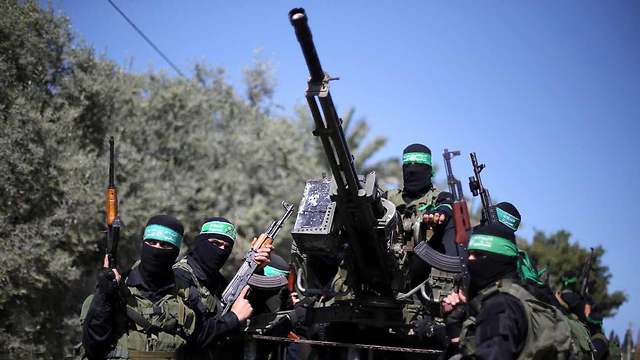
It’s time to end policy of coexistence with Hamas
Op-ed: Will the ‘return’ protests—a continuation of terrorism under the guise of ‘civilian activity’—finally make Netanyahu let go of his perception that there is no alternative to the Hamas rule in Gaza and help the PA regain control of the strip?
The forefather of this doctrine was Ehud Barak, who served as defense minister in the Olmert and Netanyahu governments from 2007 to 2013. During Operation Cast Lead, when we were a bowshot away from bringing the Hamas rule down, Barak firmly objected and forced his opinion on the cabinet and on Prime Minister Ehud Olmert, who was nearing the end of his term.
Netanyahu was elected prime minister in 2009, largely thanks to the famous video in which he was seen standing next to the fence, opposite the gates of Gaza, and promising that unlike the weakness of the Olmert-Livni government, he would bring down the Hamas rule right away. But then he broke his promise, accepted the Hamas rule in Gaza and favored a policy of coexistence with the terror organization over a military move that would bring his own rule to an end. The result was Qassam “drizzles” on the south’s residents and rounds of war every two or three years.

Netanyahu adopted the conception favoring a Hamas rule in Gaza for military, and mainly political, reasons. According to his perception, the hostility and split between the Hamas-led Gaza and the West Bank under the Palestinian Authority’s control weaken Palestinian President Mahmoud Abbas, affecting his ability to negotiate on behalf of all the Palestinian people.
Netanyahu saw the peace talks threat as much more dangerous than the terror threat posed by Hamas, which kept firing missiles and carrying out terror attacks the entire time. The PA, on the other hand, has been maintaining its security coordination with the IDF for 13 years now. This cooperation, according to heads of the IDF and the Shin Bet, has prevented—directly and indirectly—hundreds of terror attacks over the years.
Netanyahu's policy was reflected clearly in Operation Protective Edge in 2014. During the operation, Egypt, Saudi Arabia and the international community demanded an end to the Hamas rule in Gaza and sought to hand the control of the strip over to the PA. Three countries opposed the demand: Turkey, Qatar and… Israel. Netanyahu insisted on holding indirect negotiations with Hamas, and after 51 days of fighting and an Israeli death toll of 67, the sides reached a ceasefire agreement.
Moreover, in a bid to silence the voices in the cabinet and in the public demanding an end to the Hamas rule and to deter the public from supporting this policy, Netanyahu leaked a strictly confidential military document during the operation. The document stated that if the IDF tried to bring the Hamas rule down, Israel would pay a heavy price for the operation and lose hundreds of soldiers. This leak provided Hamas with an insurance policy and bolstered its self-confidence. At the end of the operation, Hamas recovered, remained in control of Gaza without any limitations, and within a short while it restored its military abilities and even expanded them.
Some people are deluding themselves that the strip could be demilitarized and that its economy could be restored in cooperation with Hamas. These are pipe dreams. Hamas won’t disarm out of its own free will, and bitter experience shows that a large part of the civilian aid eventually reaches Hamas and is used to reinforce its military needs.
The story of the terror tunnels is a good example. Israel supplied Gaza with hundreds of thousands of tons of building materials for the strip’s reconstruction. A large part of these materials was used by Hamas to build terror tunnels. The defense establishment was forced to spend billions of shekels on the development of abilities for the destruction of tunnels that were built with the construction materials that Israel gave Gaza. Complete madness.
There has recently been a change in Abbas and the PA’s stance, and they are demanding to regain control of Gaza. This demand is protected by the Oslo Agreements, which Israel is committed to. As part of the conflict with Hamas, Abbas is imposing economic sanctions which are exacerbating the terrible economic situation in the strip. According to all estimates, the situation in Gaza is on the verge of explosion. Nevertheless, Israel is standing aside and avoiding taking a stand on the developing conflict between Hamas and Abbas.
Let’s hope that the Hamas-organized “March of Return” protests, which are a continuation of terrorism under the guise of “civilian activity,” will finally make Netanyahu recalculate his route. And maybe, he will finally let go of his perception that there is no alternative to Hamas and realize that it’s time to fulfill his promise from 2009 and—together with Egypt and Saudi Arabia—help the PA regain control of Gaza.
Haim Ramon served as a Knesset member and minister from 1983 to 2009 on behalf of the Labor Party and Kadima.











